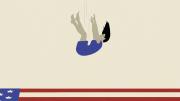“On a crisp California morning in February 2012…Marcella Wagner was driving down the interstate toward Chico State University, where she had just entered the nursing program…when suddenly another driver swerved in front of her. To avoid a collision, she jerked the wheel hard, and her car veered off the freeway. It rolled over, crushing the roof. The other driver sped off, never to be found. Marcella was seven-and-a-half months pregnant. Miraculously, the baby survived and was not harmed. But Marcella was left a quadriplegic, paralyzed from the chest down and with little use of her hands. She will need a wheelchair and round-the-clock personal care assistance indefinitely.” [Final sentence reworded 8-16-2014 to conform to language in finished book.]
Few works of social science—nowadays, all data sets and algorithms—begin this way. But this is not the lead of a news story or work of fiction. Marcella Wagner is the sister-in-law of Andrea Louise Campbell ’88, professor of political science at MIT, who studies American social-welfare, health, and tax policy. That accident not only sent a mother and a new family into physical and emotional crisis, but also thrust a new set of Americans into “the world of means-tested social assistance programs, the ‘safety net’ of public programs for the poor.” Marcella’s husband, Dave Campbell, works for a small company that offers no benefits. Marcella had temporary care for her pregnancy and for her newborn’s first two months. Once enrolled in school, she would have had coverage in a student health plan—on her way to a high-demand career where benefits are routinely available. Absent the driver at fault, whose liability insurance might have been a source of funds, Dave, Marcella, and the prematurely delivered Logan instead faced fending for themselves, with catastrophic needs.
Confronting this close-to-home case gave a new direction to Campbell’s work. Trapped in America’s Safety Net is, to be sure, a brisk work of policy analysis: a thorough—even relentless, and deeply dismaying—survey of U.S. social-insurance and -assistance programs (Social Security and Medicare in the first case; food stamps, and what is left of welfare—SNAP and TANF to use the formal acronyms—among many others, in the second) and the circumstances of those who rely on them. But Campbell grounds her work in the Dickensian details of her relatives’ exhausting new existence. Among the affronts:
• “Medicaid will pay for incontinence supplies, although fewer than Marcella actually needs; every month she has to apply and get approval for 30 additional catheters.”
• Under California’s Medicaid asset limit (which exempts their house and one vehicle, Marcella’s wheelchair van), Dave is constrained in arranging transportation to his job, so “he decided to keep a 1968 Datsun pickup” because of its low value. “It has no modern safety features. So the only able-bodied adult in the household will have to drive an unsafe car to work. And he can’t transport Logan in it because it has no backseat.”
• Medi-Cal pays for six prescriptions per month—fewer than Marcella requires.
• Marcella, whose needs seem obvious, must provide Dave’s pay stubs to maintain coverage for assistance programs, at intervals varying from three months to annually.
• And, uniquely heartless and absurd, “A local café fell behind on its taxes. Rather than see it close down, loyal patrons held a fund-raiser, which happened to take place shortly after Marcella’s accident. The café owner told the local newspaper she would give Marcella any extra funds raised.…Only problem is, the social worker reads the paper too. After the fund-raiser, she called up: Where’s the money? A lump sum could violate Dave and Marcella’s asset test”—all of $3, 150. Anything beyond that—retirement savings, funds for the baby’s future education—is impermissible.
Campbell characterizes this last humiliation as “the feeling of being hunted.” Although she prefers other apt metaphors (the book’s title, or falling down the social-assistance “rabbit hole”), this sense of entanglement in a spider’s web, struggling against ever-tighter snares, pervades her depiction of those in need. The system of assistance for the needy (which, she notes, at some point includes households to which two-thirds of Americans between the ages of 25 and 65 belong) is designed to make such aid “inferior to the alternative—the worst jobs at the worst wages.” Given pressure on low-wage work during recent decades, and current policy (not adjusting minimum wages for inflation, for instance), “most programs for the poor leave recipients in poverty.” After all, designing aid programs so recipients cannot, for example, save to educate their children seems a formula to destroy human capital.
Campbell’s analysis of how assistance programs intersect with the realities of intermittent and low-wage employment prompts a range of reactions. On the one hand, amid a welter of overlapping and inconsistent programs, one might urge policymakers to pursue thorough reform: to reallocate all current funds, at least, on the basis of recipients’ basic needs (so Marcella, for instance, doesn’t have to scrounge for catheters or prescriptions). From another perspective, the problems Campbell describes seem an insoluble morass of government malfunction that calls for junking the whole system and relying on the invisible hand of the market to pay people what their skills merit—and nothing more. But Marcella’s admittedly extreme circumstances compel at least some moral deliberation: what ought society do for those who are utterly vulnerable and dependent?
Campbell explains that Americans tolerate an incredibly patchwork “system” for dealing with life’s uncertainties. If you have a generous employer—as Campbell does, at MIT—you are reasonably well-protected. (But note: only the very rich are prepared for a lifetime of personal-care assistance, should the need arise; everyone else will end up impoverished, reliant on Medicaid. Recent Harvard fellow Michael J. Bush, impelled by his teenaged brother’s brain injury on an oil rig more than three decades ago, seeks a private-insurance mechanism to provide such help; see “Advancing Leadership,” March-April, page 38.) Those employed, but without private benefits, at least have access to a tier of reasonable public supports—like Dave. For those unable to work, or who have not accumulated sufficient service at a single employer, the means-tested social-assistance remedies are nightmarish—witness Marcella’s experience.
In other contexts—the level of taxation suitable for high-income workers, for instance—American policy has generally settled on lowering marginal rates, lest effort be discouraged. Perversely, social assistance hews to the opposite principle. “As [individuals] leave social assistance for paid work and their income rises, even modestly, they lose their eligibility for program after program,” Campbell finds. Earn a dollar more than the Medicaid threshold and you meet an “eligibility cliff,” losing coverage entirely. As Campbell drily puts it, “This is the essence of the ‘means test’ imposed” by social assistance: “as your means rise, you fail the test,” falling victim to “huge marginal taxes on those exiting social assistance for work,” a “powerful disincentive” toward behavior that anyone considers socially productive. (The Economist, no less, in mid July critiqued America’s “outdated social safety net, which manages both to be stingy and to discourage work.”)
Or take another example: “There’s one thing Dave could do to get out from under Marcella’s Medi-Cal restrictions: divorce her.” That would impoverish his wife, but it would free Dave and Logan to benefit from a higher income, if he could earn one; to accept help from family members; and to save for retirement and college expenses.
Campbell’s systematic review of the low level of American social assistance (compared to other industrial nations); its incompleteness; and its “fifty different worlds” of coverage (criteria vary by state, effectively undercutting the meaning of national citizenship, which is not the case for Social Security and Medicare) points toward wholesale rethinking and reform. Nothing in today’s politics suggests either the willingness or capacity to do so. That means Americans at large confront a reckoning, just as Marcella did. The population is aging; social insurance for the aged is becoming more costly; lower-income workers are ill-served by eroding employment-based benefits, and by assistance programs that do not focus on them; and those unable to work are even worse off.
“What’s crazy about this system,” as Campbell puts it, “is that Americans work hard and yet get so little help to facilitate working.” Compared to other nations, “Where the United States clearly fails is in not providing a basic level of protection to everyone.” Even though it is hard to be hopeful about coherent action in the current environment, two of her conclusions perhaps point toward room for bridge-building across the ideological chasm.
First, policymakers “like to believe that means-tested programs are designed to give a hand up, but some are actually designed in a way that keeps people down.”
But second (lest that be taken as an excuse to junk social assistance), “What’s contradictory is not a market economy combined with a social welfare state but rather a system that requires work but lacks the policies that make work possible.”
It should not take the extremes of suffering endured by Marcella and her family to clarify these issues. It is an act of both social-science rigor and human grace that Campbell has drawn on the details of their lives to illuminate some larger failing at the center of contemporary America.










